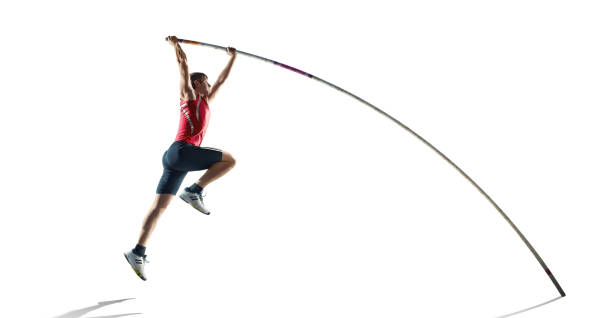Decoding the Biomechanics of Pole Vault: The Art and Science of Defying Gravity
In the realm of track and field, few events captivate audiences quite like the pole vault. This awe-inspiring discipline combines raw power, precise technique, and a touch of aerial artistry. As athletes launch themselves skyward, spectators hold their breath, witnessing a breathtaking display of human potential. But beneath the surface of this seemingly straightforward event lies a complex interplay of physics, biomechanics, and athletic prowess that has fascinated scientists and coaches for decades.

The Historical Evolution of Pole Vaulting
Pole vaulting’s roots can be traced back to ancient civilizations, where it served a utilitarian purpose rather than a competitive one. In marshy regions of the Netherlands and Great Britain, locals used long poles to vault over canals and wetlands. This practical skill gradually evolved into a military technique, with soldiers using poles to scale walls and overcome obstacles during sieges.
The transition from utility to sport began in the 18th and 19th centuries. Germany’s Turnvereine gymnastics clubs incorporated pole vaulting into their repertoire of physical activities. Meanwhile, in Great Britain, the sport gained popularity among track and field enthusiasts. The first recorded pole vault competition took place in 1843 at the Ulverston Football and Cricket Club in England.
The inclusion of pole vaulting in the modern Olympic Games in 1896 marked a significant milestone in its development as a competitive sport. Initially, vaulters used rigid poles made of hickory or ash wood, limiting the heights they could achieve. The introduction of bamboo poles in the early 20th century allowed for greater flexibility and energy transfer, leading to improved performances.
The Physics Behind the Vault
At its core, pole vaulting is an exercise in energy conversion and momentum transfer. The vaulter’s goal is to convert horizontal kinetic energy from the approach run into vertical potential energy, propelling them over the bar. This process involves several key phases, each governed by specific physical principles.
The approach run is crucial in generating the initial kinetic energy. Vaulters typically cover a distance of 30 to 40 meters, accelerating to speeds of up to 10 meters per second. This speed translates into kinetic energy, which is then transferred to the pole during the plant and take-off phases.
As the vaulter plants the pole and begins to bend it, the pole acts as an energy storage device. The fibrous structure of modern composite poles allows them to bend significantly without breaking, storing elastic potential energy. This energy is then released as the pole straightens, propelling the vaulter upward.
The moment of inertia plays a critical role during the swing and extension phases. As the vaulter inverts their body and extends upward, they manipulate their moment of inertia by changing their body position. This allows them to rotate more efficiently and achieve greater heights.
Biomechanical Analysis of the Vault
Breaking down the pole vault into its constituent phases reveals the intricate biomechanics at work throughout the event. Sports scientists and coaches analyze each phase to optimize performance and reduce the risk of injury.
- The Approach: During this phase, the vaulter focuses on building speed while maintaining proper body positioning. The goal is to achieve maximum controllable velocity. Biomechanical analysis shows that elite vaulters maintain a slight forward lean and high knee lift to optimize their stride length and frequency.
- The Plant and Take-off: This critical phase involves planting the pole in the box and transferring the runner’s horizontal momentum into the pole. Electromyography (EMG) studies have shown intense activation of the shoulder, arm, and core muscles during this phase. The timing and angle of the plant are crucial for efficient energy transfer.
- The Swing and Extension: As the pole bends, the vaulter executes a complex series of movements to position their body for the upward thrust. Kinematic analysis reveals a rapid hip flexion followed by a powerful extension of the hips and legs. This motion, combined with the energy stored in the pole, propels the vaulter upward.
- The Inversion and Bar Clearance: In the final phase, the vaulter must rotate their body to a vertical position and clear the bar. High-speed video analysis shows that elite vaulters achieve this through a combination of hip flexion, shoulder extension, and precise timing of limb movements.
Technological Advancements in Pole Design
The evolution of pole technology has been a driving force behind the ever-increasing heights achieved in pole vaulting. From the rigid wooden poles of the early 20th century to today’s advanced composite materials, each innovation has pushed the boundaries of what’s possible in the sport.
The introduction of aluminum poles in the 1950s marked a significant leap forward. These poles were lighter and more flexible than their wooden predecessors, allowing vaulters to generate more bend and, consequently, more upward propulsion. However, aluminum poles had limitations in terms of durability and energy storage capacity.
The real revolution came with the development of fiberglass and carbon fiber composite poles in the 1960s and beyond. These materials offered an unprecedented combination of strength, flexibility, and lightweight properties. Modern poles are engineered to store and release energy more efficiently, with carefully designed flex patterns tailored to individual vaulters’ techniques and body types.
Recent advancements in pole design have focused on optimizing the distribution of fibers within the composite structure. Some manufacturers now use computer modeling and finite element analysis to create poles with variable stiffness along their length, allowing for more precise energy storage and release.
Training Methodologies for Elite Performance
Achieving success in pole vaulting requires a multifaceted approach to training that goes far beyond simply practicing the vault itself. Elite vaulters engage in a comprehensive regimen that addresses all aspects of physical and technical preparation.
Strength training forms the foundation of a vaulter’s physical preparation. Exercises focus on developing explosive power in the legs, core stability, and upper body strength. Olympic lifts, plyometrics, and gymnastics-inspired movements are commonly incorporated into training programs.
Speed and sprint training are essential for generating the necessary approach velocity. Vaulters often work with sprint coaches to refine their technique and improve their acceleration and top-end speed. This training is complemented by drills that focus on maintaining proper body position and rhythm during the approach.
Technical training involves breaking down the vault into its component parts and practicing each element separately. Vaulters spend countless hours working on their plant, swing, and inversion techniques. Many elite training programs utilize video analysis and motion capture technology to provide detailed feedback on technique.
Psychological preparation is another crucial aspect of training for pole vaulters. The sport requires a high level of confidence and mental fortitude. Visualization techniques, mindfulness practices, and sports psychology sessions are often integrated into training programs to help athletes manage the mental demands of the event.
Injury Prevention and Management
The dynamic nature of pole vaulting, combined with the forces involved, makes injury prevention a top priority for athletes and coaches. Common injuries in pole vaulting include shoulder strains, wrist sprains, and lower back issues. Understanding the biomechanics of the vault has led to the development of targeted injury prevention strategies.
Strength and conditioning programs now place a greater emphasis on developing balanced musculature and addressing common areas of weakness. Core stability exercises, rotator cuff strengthening, and wrist flexibility drills are staples of injury prevention routines.
Proper technique is perhaps the most crucial factor in injury prevention. Coaches focus on ensuring that vaulters maintain proper body alignment throughout the vault, particularly during the plant and take-off phases. This helps distribute forces more evenly and reduces the risk of acute injuries.
Equipment selection and maintenance also play a role in injury prevention. Vaulters must use poles appropriate for their weight and skill level. Regular inspection of poles, landing mats, and other equipment is essential to ensure safety.
The Future of Pole Vaulting: Pushing the Limits
As our understanding of the biomechanics of pole vaulting continues to evolve, so too does the potential for further advancements in the sport. Researchers and engineers are exploring new materials and designs for poles that could unlock even greater heights.
One area of focus is the development of “smart” poles that can provide real-time feedback on bend, energy storage, and release. This technology could allow vaulters and coaches to fine-tune their technique with unprecedented precision.
Virtual reality and augmented reality technologies are also being explored as training tools. These systems could provide immersive environments for vaulters to practice their technique and mental preparation without the physical wear and tear of repeated jumps.
Genetic research and personalized training programs based on an individual’s physiological profile may become more prevalent in the future. This could lead to more targeted training interventions and potentially help identify individuals with natural aptitudes for the sport.
The Role of Biomechanics in Coaching and Technique Development
The integration of biomechanical analysis into coaching practices has revolutionized the way pole vault technique is taught and refined. High-speed cameras, force plates, and motion capture systems now provide coaches with a wealth of data to inform their instruction.
Kinematic analysis allows coaches to break down each phase of the vault in minute detail. By examining factors such as joint angles, velocities, and accelerations, coaches can identify areas for improvement that may not be visible to the naked eye. This data-driven approach has led to the development of more efficient and effective vaulting techniques.
Force plate analysis during the take-off phase provides insights into the ground reaction forces experienced by vaulters. This information helps coaches optimize the plant and take-off mechanics to maximize energy transfer to the pole.
Electromyography (EMG) studies have shed light on muscle activation patterns throughout the vault. This knowledge has influenced training programs, leading to more targeted exercises that mimic the specific muscle recruitment patterns required for successful vaulting.
The Psychological Aspect of Pole Vaulting
While the biomechanics of pole vaulting are crucial, the psychological component of the sport is equally important. The mental demands of launching oneself several meters into the air require a unique blend of focus, confidence, and risk management.
Fear management is a significant aspect of pole vault psychology. Vaulters must learn to control their fear response while attempting increasingly challenging heights. Cognitive-behavioral techniques and exposure therapy are often employed to help athletes overcome fear and anxiety.
Visualization and mental rehearsal play a vital role in pole vault preparation. Athletes spend time mentally rehearsing their vaults, imagining successful attempts in vivid detail. This practice helps reinforce neural pathways associated with proper technique and can improve performance consistency.
The concept of “flow state” or being “in the zone” is particularly relevant to pole vaulting. Athletes and coaches work to create conditions that facilitate this optimal psychological state, characterized by complete immersion in the task and a sense of effortless performance.
Ethical Considerations and Fairness in Competition
As with many sports, pole vaulting faces ongoing discussions about fairness and the role of technology in competition. The development of increasingly sophisticated poles has led to debates about whether advancements in equipment give certain athletes an unfair advantage.
Governing bodies like World Athletics (formerly IAAF) have implemented regulations regarding pole specifications to maintain a level playing field. These rules dictate aspects such as pole length, diameter, and material composition. However, as technology continues to advance, these regulations may need to evolve to ensure fair competition.
The issue of gender equity in pole vaulting has also been a topic of discussion. Historically, women’s pole vault was introduced to the Olympic program much later than the men’s event (2000 vs. 1896). Efforts to promote equal opportunities and resources for female vaulters continue to be an important focus within the sport.
Pole Vaulting’s Impact on Other Sports and Disciplines
The principles and techniques developed in pole vaulting have found applications beyond the sport itself. The understanding of energy transfer, body positioning, and momentum gained from studying pole vault biomechanics has influenced training methods in other track and field events and gymnastics.
The concept of using a flexible implement to store and release energy has inspired innovations in other sports equipment, such as pole design in pole dancing and aerial acrobatics. The physics principles underlying pole vaulting have also been applied in the development of certain martial arts techniques and parkour movements.
In the field of biomechanics research, pole vaulting serves as an excellent model for studying complex multi-joint movements and the interaction between an athlete and an elastic implement. Insights gained from these studies have applications in fields such as prosthetics design and human-machine interfaces.
The Global Landscape of Pole Vaulting
While pole vaulting is a global sport, its popularity and level of development vary significantly across different regions. Countries like the United States, Russia, France, and Germany have traditionally been powerhouses in the sport, with well-established training programs and a strong culture of pole vaulting.
In recent years, there has been a concerted effort to promote pole vaulting in developing nations. Initiatives by World Athletics and national federations aim to provide coaching education, equipment, and competition opportunities to broaden the sport’s global appeal.
The pole vault community has also embraced social media and online platforms to share knowledge and techniques. This global exchange of ideas has accelerated the dissemination of best practices and contributed to the overall advancement of the sport.
Conclusion: The Ongoing Evolution of Pole Vault
As we look to the future of pole vaulting, it’s clear that the sport will continue to evolve at the intersection of human performance, technology, and scientific understanding. The quest to vault higher will drive further innovations in training methodologies, equipment design, and biomechanical analysis.
The pole vault stands as a testament to human ingenuity and the relentless pursuit of pushing physical boundaries. It embodies the spirit of innovation that drives all athletic endeavors, constantly challenging us to redefine what’s possible when we combine skill, science, and sheer determination.
As researchers delve deeper into the intricacies of pole vault biomechanics, and as athletes continue to push the limits of human performance, we can expect to see new records set and new techniques developed. The pole vault will undoubtedly remain a captivating spectacle, inspiring awe in spectators and pushing athletes to soar to ever-greater heights.





